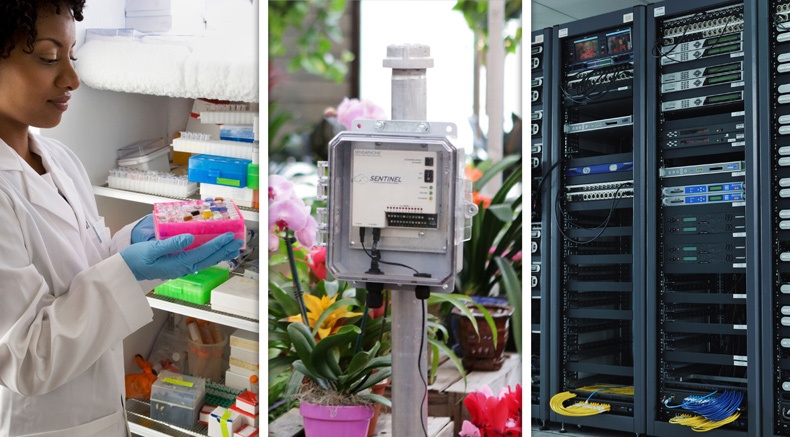
Some businesses have a choice whether or not to install a temperature monitoring system. If the heat or air conditioning systems start malfunctioning, there's not much at risk except for uncomfortable employees.
But many operations don't have that luxury. They rely on a temperature monitoring system to maintain operational efficiency, uphold quality assurance, or meet regulatory compliance. Does your business have too much at stake to ignore temperature fluctuations? Here are 3 signs that you need a monitoring system:
1. Your assets could be severely damaged by a spike or drop in temperature
For example, temperature monitoring systems play a key role in data center infrastructure management to help meet the demand for constant, uninterrupted uptime. Left unchecked, excessive heat can quickly bring a fully functional computer room to a halt. Temperature monitors are also an affordable way to control energy consumption and cooling costs. It's especially important to monitor temperature in centers that have a mix of older equipment, which runs hot, and newer pieces that run cooler, thanks to more recent technology.
Greenhouse operations are also susceptible to temperature damage. The incorrect temperature will impact the plant development and your total yield. Low temperatures can slow the growth of the plants, but too much heat can stress them. And temperature extremes either way can outright kill them. Many operators still rely on staff to manually monitor greenhouse conditions by walking the facility to physically check heaters and ventilation stacks. But humans can’t physically watch every inch of the operation around the clock. A monitoring system is always on duty, and calls the appropriate personnel immediately so they can take preventive action.
And if your business involves animals, detecting temperature problems early is critical to preventing a tragedy. Whether you raise livestock or operate a zoo or pet store, the faster you learn about dangerous temperature levels, the faster you can respond and save your animals. If your facility houses many different species, temperature settings will vary from location to location. For example, one part of a zoo building might house reptiles and amphibians, while another area is home to mammals—each requiring unique settings.
2. You have remote work areas throughout a large facility or off-site
Hotels, hospitals and office complexes must monitor environmental factors that affect the well-being of people who visit and work in their buildings. Property managers are responsible for maintaining stable ambient temperature in all interior rooms, hallways and group areas. Temperature monitoring at the facilities is also important in maintaining set water temperature ranges in bathrooms, kitchens, laundry facilities, laboratories, clinics and other areas.
Public waterworks also rely on monitoring systems to keep watch on remote pump stations, well houses and tank farms located throughout the geographic area they serve. They're used to monitor power failure in order to keep personnel at the main facility aware of any changes that could affect the performance of equipment. Equipped with additional sensors, the devices can also monitor well levels, system pressure, water pressure, and temperature as well as pump status and run time.
3. Internal and/or external regulations require you to maintain temperature records
Facilities handling vaccines, pharmaceuticals, tissue samples and other medical assets that must remain cold need to follow best practices for medical cold storage. This ensures that their inventory is in compliance with regulations and that they have the documentation to prove it when audited. Proper storage is critical for these pharmaceuticals. Any loss of potency due to improper refrigeration can reduce the safety and efficacy of the drugs.
A temperature monitoring system that includes a data logger can help. It automatically stores data that personnel can download, print and export for use in reports for internal and external regulators. When it comes to commercial food cold storage, organizations must comply with the FDA's Food Safety Modernization Act (FSMA).
Remote temperature monitoring can play a significant role in:
- Keeping food supplies safe
- Keeping organizations in compliance
- Preventing food contamination
The FSMA requires food providers to monitor and document temperatures throughout processing, transportation and distribution.
If you have specific questions about which monitoring system is right for your facility or workplace, our support team is on hand to make a recommendation. You may also be interested in What Kind of Temperature Alert Sensor is Right for You and 5 Question for Buying a Wireless Temperature Monitoring System.







